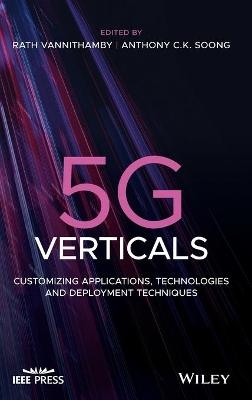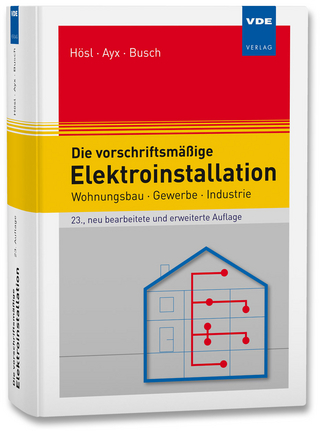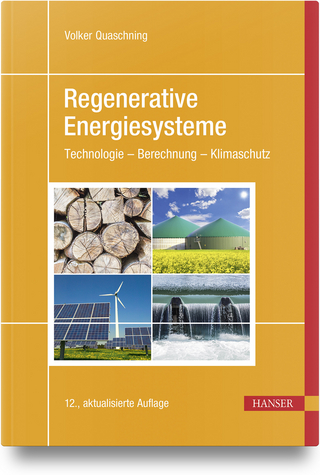
5G Verticals
Wiley-IEEE Press (Verlag)
978-1-119-51481-7 (ISBN)
5G Verticals brings together in one comprehensive volume a group of visionaries and technical experts from academia and industry. The expert authors discuss the applications and technologies that comprise 5G verticals. The earlier network generations (2G to 4G) were designed as on-size-fits-all, general-purpose connectivity platforms with limited differentiation capabilities. 5G networks have the capability to demand customizable mobile networks and create an ecosystem for technical and business innovation involving vertical markets such as automotive, healthcare, manufacturing, energy, food and agriculture, city management, government, public transportation, media and more.
5G will serve a large portfolio of applications with various requirements ranging from high reliability to ultra-low latency going through high bandwidth and mobility. In this book, the authors explore applications and usages of various 5G verticals including a set of key metrics for these uses and their corresponding target requirements. The book also examines the potential network architectures and enabling technologies to meet the requirements of 5G verticals. This important book:
Offers a comprehensive resource to the promise of 5G Verticals
Provides a set of key metrics for the uses and target requirements
Contains illustrative examples of the technology and applications
Includes contributions from experts in the field and professionals that developed the 5G standards
Provides an analysis of specific vertical industries which have the potential to be among the first industries to use 5G
Written for industry practitioners, engineers and researchers, 5G Verticals discusses the technology that enables the 5G system to be flexibly deployed and scaled.
RATH VANNITHAMBY, PhD is Senior Research Scientist at Intel Corporation, Oregon, USA. ANTHONY C.K. SOONG, PhD is Chief Scientist at Futurewei Technologies, Texas, USA.
List of Contributors xi
Preface xiii
Acknowledgments xv
Part I Introduction to 5G Verticals 1
1 Introduction 3
Anthony C.K. Soong and Rath Vannithamby
1.1 Introduction 3
1.2 5G and the Vertical Industries 5
1.3 5G Requirements in Support of Vertical Industries 10
1.4 Radio Access 12
1.5 Network Slicing 14
1.6 Other Network Issues 17
1.7 Book Outline 19
References 20
Part II 5G Verticals – Deployments and Business Model Opportunities and Challenges 25
2 5G Network for a Variety of Vertical Services 27
Jin Yang
2.1 5G Services 29
2.1.1 Enhanced Mobile Broadband 29
2.1.2 Ultra Reliable and Low Latency Communications 31
2.1.3 Massive Machine Type Communications 32
2.2 Networks 33
2.2.1 5G Network Architecture 34
2.2.2 Multi-Access Edge Computing Network 38
2.2.3 Virtualized Radio Accesses 40
2.3 Service-Aware SON 42
2.3.1 5G-NR SON Control 44
2.3.2 An Intelligent Hybrid 3-Tier SON 46
2.3.3 Service-Aware Access Scheme 48
2.3.4 Performance Benefits 50
2.4 Summary 51
Acronyms 52
References 54
Part III 5G Verticals – Radio Access Technologies 57
3 NR Radio Interface for 5G Verticals 59
Amitava Ghosh, Rapeepat Ratasuk, and Frederick Vook
3.1 Introduction 59
3.2 NR Radio Interface 60
3.2.1 eMBB 67
3.2.2 URLLC 70
3.2.3 mMTC 72
3.2.3.1 eMTC Overview 74
3.2.3.2 NB-IoT Overview 74
3.2.3.3 Coexistence with NR 76
3.3 5G Verticals 78
3.3.1 Industrial IoT 78
3.3.2 Automotive V2X 82
3.3.3 eHealth 86
3.4 Conclusion 88
Acknowledgment 88
Acronyms 89
References 90
4 Effects of Dynamic Blockage in Multi-Connectivity Millimeter-Wave Radio Access 93
Vitaly Petrov, Margarita Gapeyenko, Dmitri Moltchanov, Andrey Samuylov, Sergey Andreev, and Yevgeni Koucheryavy
4.1 Introduction 93
4.2 Blockage Effects in 5G Millimeter-Wave Cellular Communication 94
4.2.1 Millimeter-Wave Link Blockage at a Glance 94
4.2.2 Blockage Modeling Methodology 95
4.2.2.1 Geometric Representation of Blocking Objects 95
4.2.2.2 Attenuation Caused by Blocking Objects 96
4.2.2.3 Channel Models 96
4.2.2.4 Blockage States 96
4.2.3 Accounting for mmWave Blockage 96
4.2.4 Summary 97
4.3 Modeling Consumer 5G-IoT Systems with Dynamic Blockage 97
4.3.1 Spontaneous Public Event 97
4.3.2 Moving Through the Crowd 98
4.3.3 AR Sessions in Dense Moving Crowd 100
4.3.4 Connected Vehicles 102
4.3.5 Summary 103
4.4 Dynamic Multi-Connectivity 103
4.4.1 Multi-Connectivity at a Glance 103
4.4.2 Optimizing the Degree of Multi-Connectivity 104
4.4.3 Modeling 5G NR Systems with Multi-Connectivity 105
4.4.4 Impact of Multi-Connectivity Policy 107
4.4.5 Summary 108
4.5 Bandwidth Reservation 109
4.5.1 Session Continuity Mechanisms 109
4.5.2 Concept of Bandwidth Reservation 109
4.5.3 Summary 110
4.6 Proactive Handover Mechanisms 111
4.6.1 Dynamic Blockage Avoidance 111
4.6.2 Deterministic AP Locations 112
4.6.3 Deterministic UE Locations/Trajectories 113
4.6.4 Summary 114
4.7 Conclusions 114
References 115
5 Radio Resource Management Techniques for 5G Verticals 119
S.M. Ahsan Kazmi, Tri Nguyen Dang, Nguyen H. Tran, Mehdi Bennis, and Choong Seon Hong
5.1 Introduction 120
5.2 5G Goals 120
5.3 Radio Access Network Management 121
5.4 Network Slicing 124
5.5 Use Case: Virtual Reality 125
5.5.1 System Model 125
5.5.2 Problem Formulation 127
5.5.3 ADMM-Based Solution 128
5.5.4 Performance Analysis 131
5.6 Summary 131
References 133
Further Reading 135
Part IV 5G Verticals – Network Infrastructure Technologies 137
6 The Requirements and Architectural Advances to Support URLLC Verticals 139
Ulas C. Kozat, Amanda Xiang, Tony Saboorian, and John Kaippallimalil
6.1 Introduction 140
6.2 URLLC Verticals 141
6.2.1 URLLC for Motion Control of Industry 4.0 141
6.2.2 Multi-Media Productions Industry 142
6.2.3 Remote Control and Maintenance for URLLC 142
6.2.4 Vehicle-to-Everything 144
6.3 Network Deployment Options for Verticals 145
6.4 SDN, NFV and 5G Core for URLLC 147
6.4.1 SDN for URLLC 147
6.4.2 NFV for URLLC 148
6.4.2.1 NFV Background 148
6.4.2.2 Reducing Virtualization Overhead on a Single Physical Server 149
6.4.2.3 Evolution of NFV toward Cloud Native Network Functions 152
6.4.3 5G Core and Support for URLLC 154
6.5 Application and Network Interfacing Via Network Slicing 161
6.6 Summary 165
References 165
7 Edge Cloud: An Essential Component of 5G Networks 169
Christian Maciocco and M. Oğuz Sunay
7.1 Introduction 170
7.2 Part I: 5G and the Edge Cloud 170
7.3 Part II: Software Defined Networking and Network Function Virtualization 175
7.3.1 Rise of SDN 176
7.3.2 SDN in Data Centers and Networks 176
7.3.3 Network Function Virtualization 179
7.4 Evolving Wireless Core, e.g. OMEC, Towards Cloud Native and 5G Service-Based Architecture 184
7.4.1 High Volume Servers’ Software and Hardware Optimization for Packet Processing 188
7.4.1.1 Data Plane Development Kit 188
7.4.1.2 Flow Classification Bottleneck 190
7.4.1.3 Cuckoo Hashing for Efficient Table Utilization 190
7.4.1.4 Intel Resource Director Technology 192
7.5 Part III: Software-Defined Disaggregated RAN 193
7.5.1 RAN Disaggregation 193
7.5.2 Software-Defined RAN Control 194
7.6 Part IV: White-Box Solutions for Compute, Storage, Access, and Networking 197
7.7 Part V: Edge Cloud Deployment Options 200
7.8 Part VI: Edge Cloud and Network Slicing 204
7.9 Summary 207
Acknowledgments 207
References 208
Part V 5G Verticals – Key Vertical Applications 211
8 Connected Aerials 213
Feng Xue, Shu-ping Yeh, Jingwen Bai, and Shilpa Talwar
8.1 Introduction 213
8.2 General Requirements and Challenges for Supporting UAVs over a Cellular Network 215
8.3 Summary on Current Drone Regulations 217
8.4 Review of Aerial Communication R&D Activities in General 217
8.4.1 R&D Activities from Industry and Government Agencies 217
8.4.2 Academic Activities 218
8.4.3 3GPP Activities in General 219
8.5 3GPP Enhancement on Supporting Drones 220
8.5.1 3GPP Drone Study Item and Work Item in RAN1 220
8.5.2 3GPP Drone Study Item and Work Item in RAN2 223
8.6 5G Challenges, Solutions, and Further Studies 225
8.6.1 Challenges, New Emerging Usages, and Requirements for 5G 225
8.6.2 3GPP Features Addressing These New Requirements 227
8.6.2.1 eMBB 227
8.6.2.2 URLLC 228
8.6.2.3 Massive Machine-Type Communications 228
8.6.2.4 V2X 228
8.6.2.5 Next Gen Core Network 229
8.6.2.6 Positioning 229
8.6.3 Further Study Needed for Aerial Vehicles in 5G 229
Acronyms 231
References 231
9 Connected Automobiles 235
Murali Narasimha and Ana Lucia Pinheiro
9.1 Introduction 235
9.2 Levels of Vehicle Automation 238
9.3 Multi-Access Edge Computing in 5G 239
9.4 Platoon-Based Driving Use Case 240
9.4.1 Platoon Model 242
9.4.2 Edge Computing for Platooning 249
9.5 High Definition Maps Use Case 251
9.5.1 HD Maps Procedures 253
9.5.1.1 Map Download Procedure 253
9.5.1.2 Map Update Procedure 254
9.5.2 Edge Computing for HD Maps 257
9.6 Summary 259
Acknowledgment 261
References 261
10 Connected Factory 263
Amanda Xiang and Anthony C.K. Soong
10.1 Introduction 263
10.2 5G Technologies for the Manufacturing Industry 264
10.2.1 Ultra-Reliable and Low-Latency Communications 264
10.2.2 Enhanced Mobile Broadband 264
10.2.3 Massive Machine Type Communication 265
10.3 5G Alliance for Connected Industries and Automation 266
10.4 Use Cases 268
10.4.1 Motion Control 270
10.4.2 Control to Control Communication 272
10.4.3 Mobile Control Panels with Safety Functions 272
10.4.4 Mobile Robots 273
10.4.5 Massive Wireless Sensor Networks 273
10.4.6 Remote Access and Maintenance 274
10.4.7 Augmented Reality 275
10.4.8 Process Automation – Closed Loop Control 276
10.4.9 Process Automation – Process Monitoring 276
10.4.10 Process Automation – Plant Asset Management 276
10.4.11 Inbound Logistics 276
10.4.12 Wide Area Connectivity for Fleet Maintenance 277
10.4.13 High-End Camera 278
10.5 3GPP Support 278
10.5.1 5G Use Case and Requirements for Smart Factory 278
10.5.2 5G Standardized Solution Development for Smart Factory 282
10.5.2.1 5G System Architecture for Smart Factory (SA2) 282
10.5.2.2 Other 3GPP Work for Smart Factory 284
10.6 Early Deployments 287
10.6.1 Spectrum 287
10.6.2 Early Trials 288
10.7 Conclusions 289
Acronyms 290
References 290
Index 293
| Erscheinungsdatum | 07.08.2019 |
|---|---|
| Reihe/Serie | IEEE Press |
| Sprache | englisch |
| Maße | 158 x 230 mm |
| Gewicht | 590 g |
| Themenwelt | Technik ► Elektrotechnik / Energietechnik |
| Technik ► Nachrichtentechnik | |
| ISBN-10 | 1-119-51481-9 / 1119514819 |
| ISBN-13 | 978-1-119-51481-7 / 9781119514817 |
| Zustand | Neuware |
| Informationen gemäß Produktsicherheitsverordnung (GPSR) | |
| Haben Sie eine Frage zum Produkt? |
aus dem Bereich


